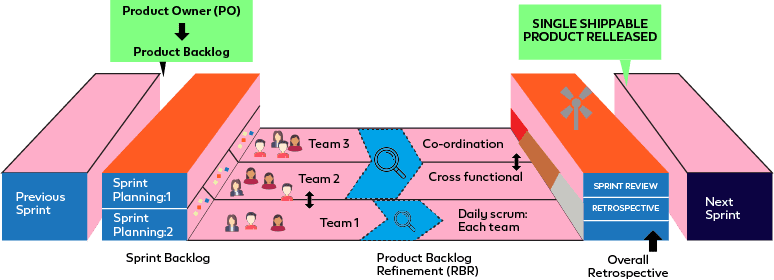Scaling Scrum for Large Projects or Large-Scale Scrum (LeSS)
- June 27, 2023
- Posted by: Revathy B
- Category: Digital Assurance

Introduction: What is Large Scale Scrum (LeSS)?
If you are envisioning scaling your scrum project to a larger level, then Large Scale Scrum (LeSS) by Bas Vodde and Craig Larman is the best choice to adopt and enforce. As the traditional scrum framework, LeSS is also an agile framework that qualifies for scaling scrum on a large scale. LeSS was refined with a substratum of one scrum team, as expounded by Jeff Sutherland and Ken Schwaber in the Scrum Guide conglomerates, and this applies to numerous teams that collaborate to deliver one shippable product. Companies specializing in digital assurance services can support digital teams in examining and enhancing these processes.
The LeSS framework adheres to all the Scrum values: Respect, Courage, Openness, Focus, and Commitment.
Let’s understand LeSS by way of example. Say that you have four agile teams employed currently, and now you aspire to develop a large, complex product that will only be successful if your teams coordinate closely. The traditional scrum is too incompetent to continue in this situation. Well, what is the next step? Numerous frameworks are available for scaling Scrum, but here we will take a deep dive into LeSS.
 Types of LeSS
Types of LeSS
LeSS branches off 2 two types:
(I) Basic LeSS is analogous to traditional scrum teams, where the scrum team varies from 2 to 8 teams.
(II) LeSS Huge has a focus only on large enterprises where more than 8 Scrum teams work together to deliver a single shippable product.
In this blog, we are only going to focus on LeSS Huge.
Experiments, Guides, and Principles of LeSS
Numerous experiments were conducted under the direction of Bas Vodde and Craig Larman to promote Scrum, and they defined the framework for large-scale Scrum with ten guiding principles. These aid large businesses in escalating their conventional scrum. The following guidelines were forged to scale the scrum on a large scale:
- Scrum at scale is Scrum.
- Transparency, empirical process control
- More with less
- Product focus throughout
- Customer-centric
- Ongoing development in the pursuit of perfection
- Systems analysis
- Lean thinking
- Theorem of queues
Since the principles are self-explanatory, I won’t list them all here.
 Key differences between traditional and large-scale scrum
Key differences between traditional and large-scale scrum
| S.No | Traditional Scrum | Large Scale Scrum (LeSS) |
| 1 | Traditional Scrum is the agile framework depicted for project management. | LeSS framework is also a scrum framework that is used in large enterprises that warrants you to adopt and enforce Scrum at a large scale |
| 2 | Traditional Scrum has 2 to 8 teams varying project specific. | LeSS is molded from Scrum to support its use in larger enterprises. |
| 3 | Members of a scrum team are typically 10 or fewer people | LeSS branches off 2 two types: Basic LeSS for 2 to 8 teams and LeSS Huge exceeds 8 teams. |
| 4 | Members of the traditional Scrum comprehends one Product Owner, one Scrum Master, and Developers. | Members of the Large-scale Scrum also encompass one Product Owner, one Scrum Master, and Developers. On top of that, there is Area Product Owner (APO) and a manager. |
| 5 | Each team has its own product goal. | Multiple teams work together on a sole product i.e., all teams have one product goal shared. |
| 6 | Each team has its own sprint. | All teams have a sprint in common for them focusing on delivering single shippable product |
Roles in LeSS: LeSS has the same roles as the classic scrum, including a Product Owner, Scrum Master, and Development team. Less more duties, which are described below, but with:
Product owner: Has control over the direction, vision, and objective of the product. He makes decisions, defines the product goal, and is in charge of managing the product backlog. The product owner role is expanded in LeSS Huge, namely, to include Area Product Owners (APO), who interact and coordinate across numerous teams.
Area product owner (APO): An Area Product Owner will act as ‘Product Owner’ for their respective teams with more focus on a customer-centric area.
Scrum Master: Accountable for establishing Scrum Also, supervise the team with ceaseless enhancement and be accountable for unclogging any issues raised and taking the next step needed.
Development team: It includes both the developers and testers, and it’s liable for product construction and shipment to the customer.
Manager: The manager supervises by assisting the team with eliminating obstacles for constant improvisation and self-determination.
Team members in LeSS are self-managing, cross-functional, apportion responsibility for all the team’s work, have a shared team goal, and are accountable for managing their own relationships with external teams and people.
Also read this informative blog on Minimum Viable Architecture for Agile Development.
Events in LeSS
With fewer extra events included in LeSS and some modifications made to the current events, LeSS Huge adheres to some of the same processes as standard scrum, including sprint planning, daily scrum, sprint review, and sprint retrospective.
Sprint Planning: In LeSS, sprint planning is split into two phases. During the first phase, all teams collaborate to decide how to divide the work items on the product backlog, and during the second, each team prepares its own sprint work items in conjunction with other teams.
Daily Scrum: DSM is used as the single-team scrum in LeSS. Every team in the scrum holds a daily 15-minute meeting during which all team members jump on a call to address two topics: what was accomplished, the plan for the day, and any obstacles. The Scrum Master is responsible for clearing any obstacles brought up and taking the necessary action.
Product Backlog Refinement (PBR): PBR is a recursive meeting in which the Scrum team members come together to discuss, focus on, and revise the work items in order to prepare for the following sprints. PBR activities include estimating risks, values, dependencies, and story points as well as providing clarification and amending the user story as necessary.
Sprint Review: Sprint Review is held overall for all teams in LeSS, where the focus is on the whole shippable product.
Sprint Retrospective:
- Sprint Retrospectives will be held for each team separately.
- Additionally, an overall retrospective will be conducted that talks about how all teams aligned and worked closely together during the sprint.
Unlock Agile Excellence with LeSS, Contact us today for more information.
Click here
Conclusion
LeSS framework spotlight’s goal, to sum up, is not to invent a new framework but rather to implement Scrum’s ideas and principles as clearly as possible within the context of a huge organisation by means of established rules and norms. By doing so, any company or organisation can build their team’s ability to interact practically with and observe facts or events using LeSS, allowing them to transition from standard Scrum to Large Scale Scrum.





